Koreshan Historic Site – Seven Reasons to Visit
Alison and I have been driving by the entrance to Koreshan State Historic Site just off Highway 41 south of Fort Myers for at least twenty-five years and we’ve never gone in – until today. I had enough interest in the place to know that it was an historic site of a religious community that had existed at the turn of the 20th century, but knew little else. Somehow when we decided to visit a state park we always ended up going to one that featured hiking trails or canoe routes or good birding, like Kissimmee Prairie or Myakka River. Little did I know that Koreshan has all of this and more. It is anything but a one dimensional park based around a single attraction; in fact we found seven compelling reasons to visit. Here they are.
1. The History of the Koreshan Unity Community
The 19th century witnessed an explosion of new religious based sects that all shared one thing in common – a professed adherence to Christian doctrine, even though they differed wildly in the manner in which that doctrine was interpreted and practiced. While most of the sects, or cults as some would call them, petered out, others thrived and have worldwide followings today – The Latter Day Saints (Mormons) Christian Scientists and Jehovah’s Witnesses readily spring to mind. The Koreshans were one of those groups on the losing side of history, but while they lasted they had some great ideas and some extremely wacky ones as well.
Koreshanism was founded by Cyrus R. Teed, who had medical training, but appears just as likely to have been a quack. He claimed to have had an illumination that revealed to him the secrets of the universe which included the fact the the earth is hollow and we actually live inside it. He also had a vision of God as a woman. Over time he developed a full blown religion that was centred on communal living, abstinence from drugs, alcohol and sex and the search for the New Jerusalem. Sound familiar? You can’t draw a following without real charisma and apparently Teed, who now styled himself Koresh, had it in spades, particularly to women. Koresh was the Persian name for Cyrus and apparently means ‘shepherd’. The religion had some success in Chicago and attracted hundreds of followers. In pursuit of the New Jerusalem, Teed decided to move his followers to a remote place where they could live in peace and build their paradise on earth. Again, sounds familiar right?
In 1894 many of his Chicago disciples said goodbye to the big city, put everything they could carry on a train and headed for Florida, in particular, the then almost completely uninhabited Estero Island. Teed convinced Jacob Damkohler, the only person living in the area to donate land for the commune. The plan was to build a city of ten million based on this design as painted by Moses Weaver in 1902. How they would get up to ten million while remaining celibate seems to have been overlooked.
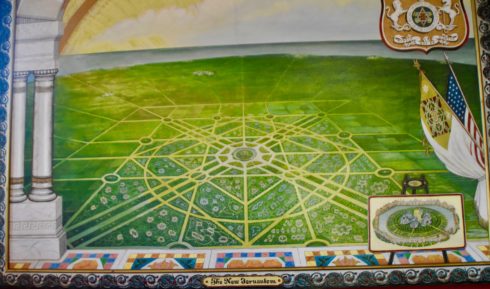
Initially the commune was quite successful with Teed overseeing the building of a landing on the Estero River to which all the needed supplies were barged. Next came a large two story house for himself, followed by gardens, the Planetary Court (which I’ll expound upon shortly), an Art Hall for performing arts and numerous buildings designed to make communal living easier. These included a bakery, several machine shops, a generator shed and general store. Amazingly, most of them survive today.
Teed died in 19o8, two years after a savage beating by Fort Myers Marshall S.W. Sanchez that was the culmination of bad blood between the communists and the ‘ordinary’ Christians of the area. Without Teed, the commune gradually faded away, but it was a slow death. In 1961 the few remaining Koreshans donated the 350 acres on which their New Jerusalem was to have thrived, to the State of Florida which has wisely preserved it as a State Historic Site. Hedwig Michel, the last surviving Koreshan, died in 1982. With this very intriguing history as the bait, let’s see what’s there today.
2. Koreshan State Historic Site
One of the reasons we decided to visit the Koreshan site today was that they were also hosting a farmer’s market and a quilt and antique engine show on the site. In my ignorance about the place, I assumed there might not be enough to justify a visit only to the historic site. They were also advertising a 10:00 guided tour. When we got there it turned out the guided tour for that week was not on because of all the other activities going on. The volunteer who took our $5.00 entry fee to the park assured us that we would be able to learn all we needed without benefit of a guide, and she was right.
As I mentioned above, despite being made of wood, many of the Koreshan buildings have survived the ravages of fire and hurricanes and a visit to the site is almost akin to going to one of those ‘historical villages’ you find all over North America. The point is, I was expecting to see maybe a dilapidated building or two and maybe some foundations, but not fully functional buildings that are still being used by the SW Florida community today. A building over 100 years old is a rarity in southern Florida and here were a dozen of them in one location.
A self-guided tour of the site is quite feasible, especially if you spend the princely sum of 50 cents on a Koreshan Unity Settlement pamphlet that gives the history of the movement and details of seventeen marked locations on the property grounds. If you are really cheap you can settle for the small brochure with a map that you get with the entry fee. There are also a number of interpretive panels on site, plus this historical marker.
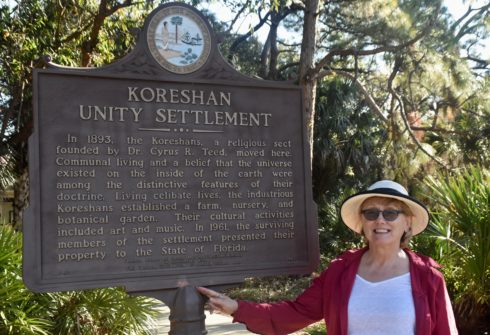
I strongly recommend starting your visit by going to the Founder’s House where there is about a fifteen minute film with a lot of original photos and film that tells the story of the Koreshans in enough detail to make one look forward to exploring the place, but without becoming boring. There is a recreation of Teed’s original study in this building as well. It seems he was a fan of Napoleon.
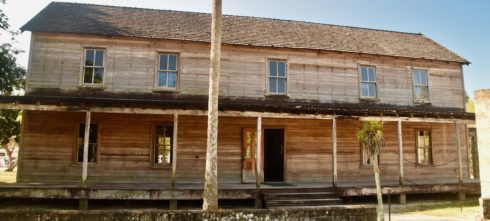
Beside the Founder’s Residence, which is the second largest building remaining on site, is the smallest, the Damkohler Cottage where Teed and a few others lived while the larger dwelling was being constructed. The difference in size is striking.
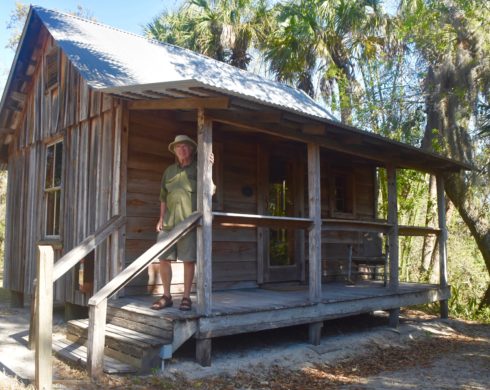
The Koreshans, built a sawmill, rapidly learned how to build more sophisticated buildings and by 1905 had constructed the Art Hall which is still being used for concerts today.
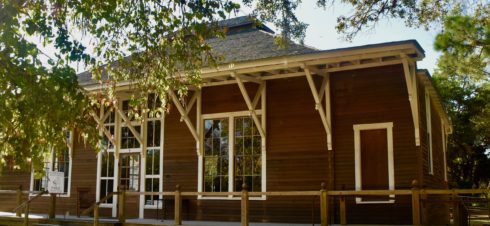
This is the stage where the Koreshans put on plays, including Shakespeare, concerts and lectures. It also doubled as the dais or altar from where the religious activities of the Koreshans were practiced.
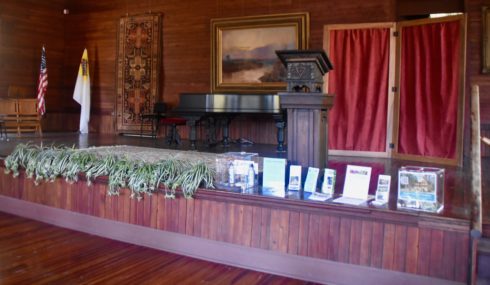
What is conspicuously absent from the Koreshan Unity Settlement is any building that could be described as a church or any symbols that are obviously Christian. This symbol on what I suppose was a pulpit was a close as any that we saw. At first it looks like a Star of David, but the circle inside the star with what might be another star makes it clear that it is not. I was unable to find any information about this symbol either from people on site or on the net.
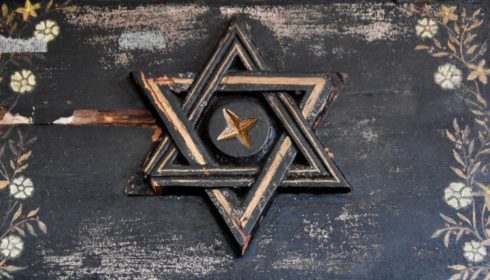
Also inside the art hall are paintings by Koreshans, some of which are pretty simple, almost like folk art, while others, particularly by Teed’s son Douglas are more sophisticated. Regardless of style, these represent some of the earliest surviving paintings of the Estero Island area.
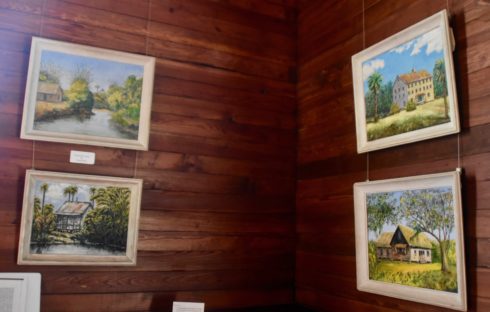
Also in the Art Hall is the single most important and, to me, interesting artifact on the entire site, the Koreshan representation of the universe. A quick glance at this might trick the eye into thinking that this is a two-dimensional map of the world, but it’s actually two concave sides of the earth that can be closed around the inner sphere, recreating ‘the universe’ as the Koreshans believed it to exist. When a Koreshan looked up at the sun or the night he sky he/she believed they were just seeing reflections and not real objects. Batty or what?
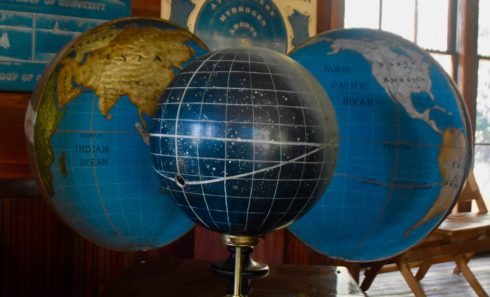
Also on display is this supposed refutation of the ‘proof of convexity’ demonstrating that the world’s surface is not convex or outwardly curved, but rather the opposite. Who knew?
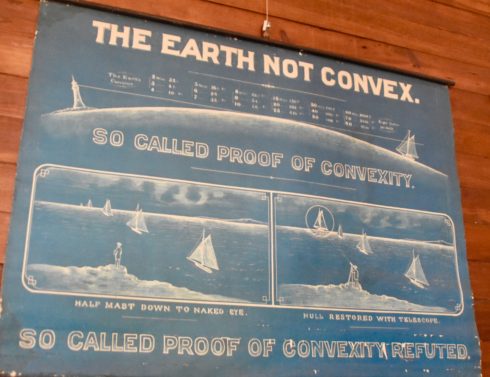
If the most interesting items on display are in the Art Hall, the most interesting building is the nearby Planetary Court where more of Teed’s ideas were put into practice.
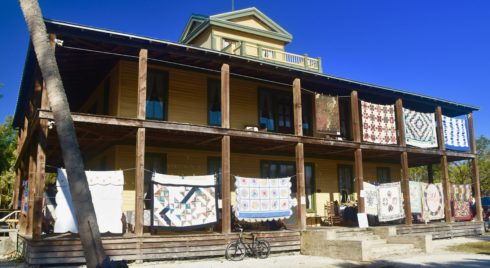
Although many of Cyrus Teed’s ideas were simply loony, many others were progressive and well ahead of his time, particularly his views on women. He believed absolutely in the equality of men and women, so much so that he designated seven women to run the actual day-to-day business of the settlement. They were designated as the Planetary Court and they had to live in the building of the same name, each having their own room. Most of the furnishings had been brought from Chicago and it appears the ladies lived very comfortably considering the state of most other SW Florida homes at the time.
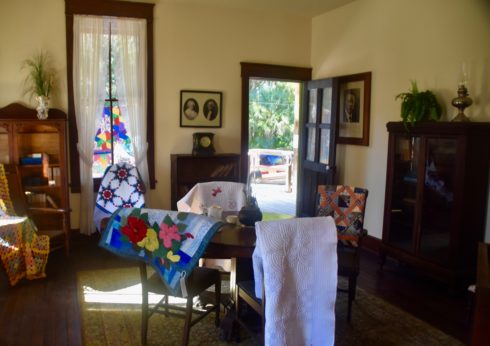
How well the ‘seven sisters’ got along in this strange living arrangement is not known, but it is a fact that after Teed’s death, his designated successor was one of the Planetary Court members. Despite professions of sexual equality, her status as leader was never really accepted and soon after the decline of the Koreshans began in earnest.
The Koreshans were very modern in their use of technology, including adaption of electricity at the settlement well before the city of Fort Myers became electrified. As most Floridians know, Thomas Edison spent the winters in Fort Myers and had a large laboratory there which is one of the largest tourist draws in SW Florida . Edison and Teed were apparently good friends so it was no surprise that Teed agreed to generate electricity at Koreshan, using Edison’s methods, after the people of Fort Myers had declined the offer. There are three buildings on site dedicated to machine works and electricity generation.
The last purely Koreshan site we visited was, fittingly, the grave of the last Koreshan, Hedwig Michel. Her epitaph reads, “Be ashamed to die until you have won some victory for humanity”.
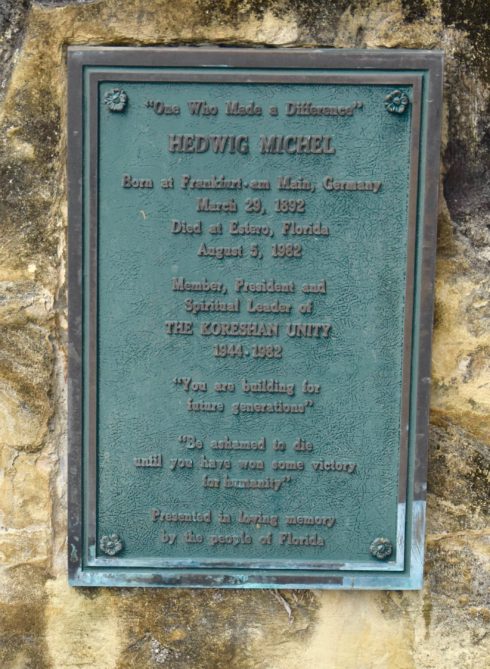
3. The Bamboo Trail
The visit to the Koreshan buildings was but the beginning of our exploration of this 200 acre park. The bamboo landing which was the original debarkation point for arriving Koreshans, is a great place to just sit and watch the lazy flow of the Estero River as it makes its way to Gulf of Mexico.
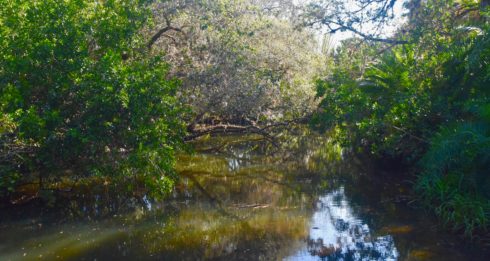
It’s also the beginning of one of the most interesting short hiking trails in SW Florida, a walk through sandy soil along the banks of the Estero through a native cane break or as most people would call it, a bamboo forest. There is only one native species of bamboo in North America and you can find it many parts of Florida, but seldom as a complete eco-system of its own. We have hiked many, many trails in Florida, but never one like this.
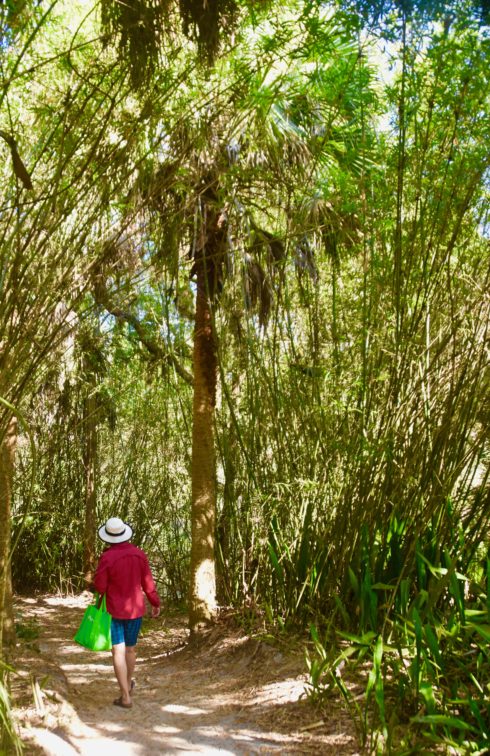
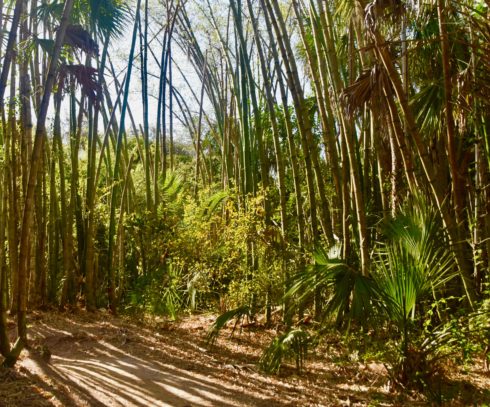
Here’s Alison with literally, the big bamboo.
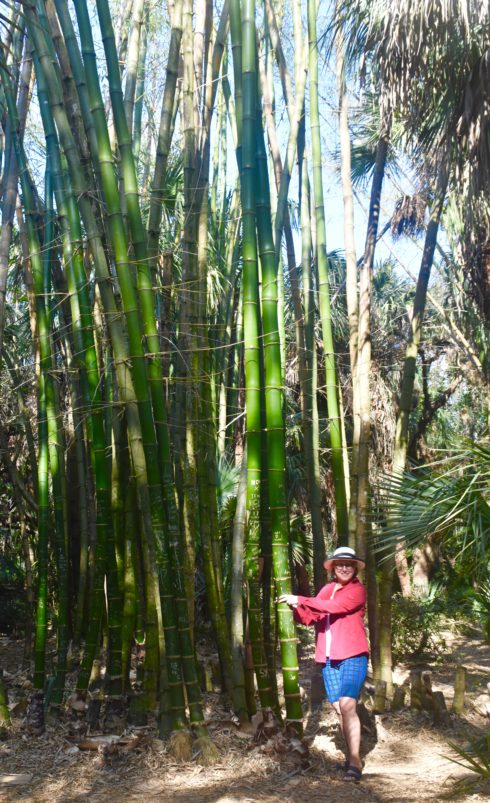
After the bamboo forest peters out you can return to the Koreshan buildings via a circular route through a slash pine forest or continue on along the river as we did. This will take you to the next great activity at Koreshan park.
4. Canoe or Kayak the Estero
If you’ve walked the trail through the bamboo forest as far as the boat ramp at the far side of Koreshan park you will no doubt have seen canoeists and kayakers making their way up and down the Estero River. The Estero is a very shallow and slow moving river that in parts is completely canopied with live oak and other overhanging branches. Even novices should have no trouble paddling upstream and of course, coming back down, it’s just a matter of letting the river do its thing. All you need to do is use the paddle as a rudder.
You can rent canoes or kayaks at the boat ramp or bring your own. Either way its a great place to start exploring one of SW Florida’s greatest attractions, the Calusa Blueway.
5. Pitch a Tent in Koreshan
It’s no secret that finding a good spot to pitch a tent in SW Florida is not that easy. Commercial parks cater overwhelmingly to RVers, many of whom have semi-permanent setups. Those that do accept tent campers often put them in the least desirable sites, often without shade. The State Park facilities at Koreshan offer really terrific camp sites alongside the Estero River. There are nice sites for RVers as well, but they are completely separate from the tenting sites which are well shaded. We noticed a lot of families and groups of young men and women, most with kayaks or paddle boards nearby. If you are looking for a quiet place to set up and use as a base to explore the backwaters of Estero, I doubt you can do much better than Koreshan.
6. Enjoy a Fresh Baked Pretzel at the Cast Iron Cafe
One of the Koreshan buildings has been converted into an open air cooking area where, on every second weekend, volunteers cook a variety of items on, what else, an old fashioned cast iron stove.
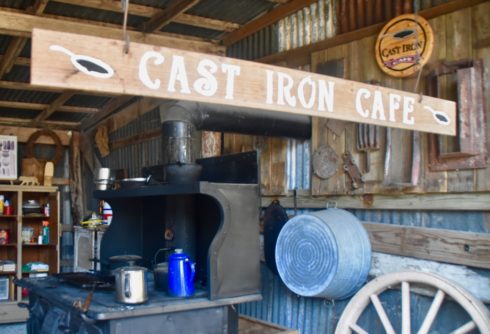
Adopting the same recipes as used by the Koreshans they turn out buckwheat pancakes, Koreshan white bread, plain fired grits and our favourite, pretzels. If you’ve never tasted a fresh baked pretzel covered with flakes of salt then you haven’t lived. They are delicious and best of all, they’re free. All the volunteers ask is a donation to help them pay the cost of the supplies.

7. Enjoy one of the many Special Events held at Koreshan
As I mentioned earlier, what finally got Alison and me to Koreshan was the other events that were also going on there. These included the farmer’s market where we ended our visit by stocking up on fresh vegetables – Canadians have no idea how good the Florida tomatoes are in winter. What we get at home are hard and tasteless. I also scored two packages of freshly ground Kenyan coffee from Francis and Georgeline Coffee which imports the beans and roasts them weekly. Ever since our recent visit to Kenya I have been hooked on the taste of Kenyan coffee and was doubtful of getting any in Fort Myers. My doubts were put to rest at Koreshan.
For women, the main attraction was definitely the quilt show. The Planetary Court was festooned with them, inside and out.
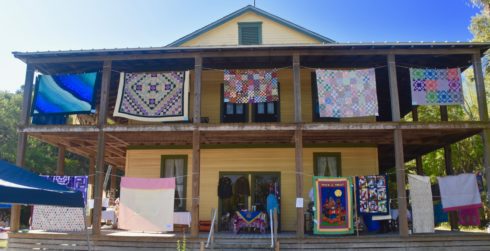
There were displays of quilt making for novices and experts alike as well as this lady who was demonstrating how to make yarn using a modern spinning wheel.
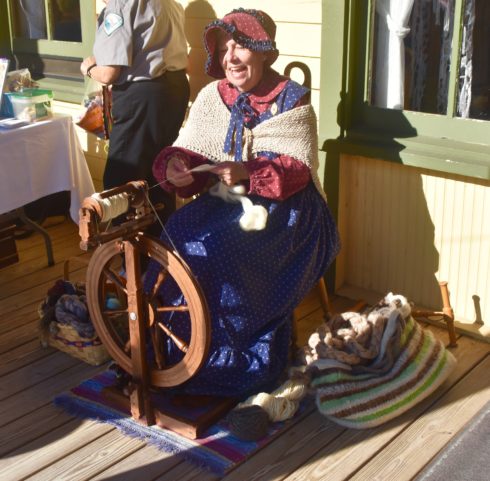
For men, the attraction was the display of antique engines on display, most in working order including this early version of a gas powered water pump.

This brightly coloured Willys-Overland Jeepster drew a lot of attention.
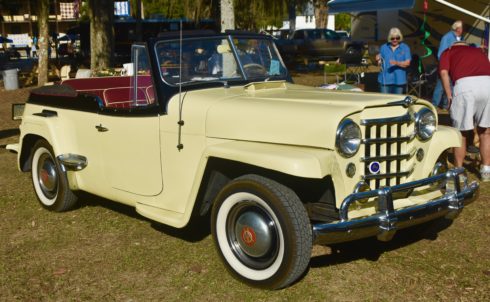
Future events at Koreshan include weekly concerts in Art Hall, cooking demonstrations, yoga and meditation sessions plus a number of events on the Estero River.
Whether you think Cyrus Teed was a nut or a misunderstood humanitarian there can be no doubt that he has left the people of Florida a lasting legacy (and a great tourist attraction) in Koreshan State Historic Park.
One final note, I can find absolutely no evidence that there is any connection between the notorious cult leader Vernon Wayne Howell who also adopted the name Koresh, (adding David for good measure) and the Koreshans of Florida.

